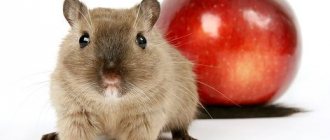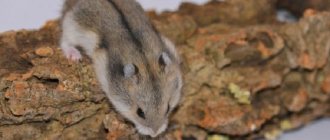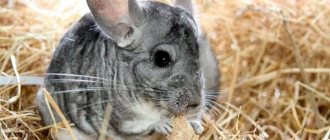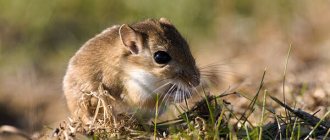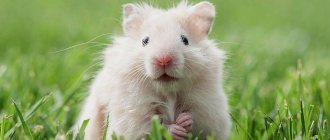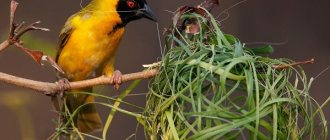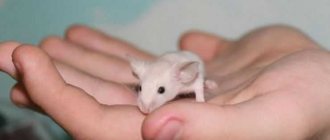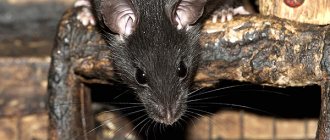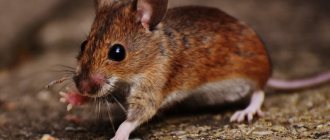Description of rats
Representatives of the mouse-like suborder are by far the most common animals on our planet . Rats have significant differences from mice in behavior and appearance. They are larger in size, more muscular and denser in build, with a noticeably elongated muzzle and an elongated nose. The rat's eyes are quite small.
At the very first sign of danger, rodents of the Mouse family actively secrete a strong-smelling liquid, thanks to which other members of the species are warned. Due to the peculiarities of their body structure, they are able to easily squeeze into even the tiniest holes, the diameter of which does not exceed a quarter of the girth of the rodent itself.
Appearance
Rats have an oval-shaped body and a fairly stocky build, which is very characteristic of a significant part of rodents. The average body length of an adult varies between 8-30 cm, and the weight of a rat can range from 38 g to 500 g. Some, sometimes very noticeable, external differences depend on the species characteristics and habitat of the rodent mammal.
The rat's muzzle is elongated and pointed, with small eyes and ears. The tail of most species existing today is almost completely bare, covered with scales and sparse hairs. The black rat is characterized by the presence of thick fur on its tail. The length of the tail is usually equal to the size of the body and often even exceeds it, but there are also so-called short-tailed rats.
On the jaws of a mammalian rodent there are two pairs of noticeably elongated incisors. Molars are characterized by a dense arrangement in rows, due to which fast and active grinding of food occurs. Between the molars and the incisors there is a diastema, represented by an area of the jaw without teeth. Despite the fact that such rodents belong to the category of omnivores, they are distinguished from predatory representatives of the fauna by the complete absence of fangs.
The animal's incisors require constant grinding, which allows the rat to fully close its mouth. This feature is explained by the absence of roots, as well as the continuous and active growth of the incisors. The front part of the incisors is covered with hard enamel, but on the back surface there is no such enamel layer, due to which the grinding of the incisors occurs unevenly, so the teeth acquire a characteristic chisel shape. Absolutely all teeth are incredibly strong and can easily gnaw through concrete and brick, alloys and any hard metals, but initially by nature they were intended for eating food exclusively of plant origin.
This is interesting! The coat of rats is dense and relatively thick due to well-defined guard hairs. The fur color can be grayish-brown or dark gray, sometimes with reddish, orange and yellow shades.
Rats have poorly developed calluses on their paws, which are necessary for rodents to quickly climb on a variety of surfaces. However, this functional deficiency is very well compensated by very tenacious and mobile fingers. It is thanks to this feature that rats lead both a terrestrial and semi-arboreal lifestyle, are able to climb trees and set up nests in abandoned hollows of other animals or birds of sufficient size.
Lifestyle, behavior
Rats are by nature incredibly active and very hardy animals . They run well, and at the first sign of danger they can easily reach speeds of up to 10 km/h and overcome meter-high obstacles. The daily exercise of such representatives of the mouse-like suborder is, as a rule, from 8 to 15-17 km. Rats can swim and dive very well, are able to catch fish that are not too large, and can continuously stay in the water for more than three days without any damage to life or health.
As a shelter, rodents use holes dug themselves or abandoned by other animals, as well as natural and artificial shelters, and the nests of various birds. Rats are able to live both alone and forming territorial communities with different numbers of individuals or family groups. Within one colony, most often consisting of several hundred individuals, a rather complex hierarchy is formed with the presence of a dominant male, as well as several dominant females. The individual territory of each such group may well reach two thousand square meters.
The rat's vision is not well developed and has a small viewing angle of no more than 16 degrees. For this reason, the animal is forced to almost constantly turn its head in different directions. The surrounding world is perceived by such rodents exclusively in shades of gray, and complete darkness for them is represented by the color red.
This is interesting! The sense of smell and hearing in representatives of the Rat genus functions just fine, so these animals easily perceive sounds with a frequency within 40 kHz.
Rodents are able to detect odors at a short distance, but rats can easily tolerate radiation exposure up to 300 roentgens/hour.
How long do rats live?
The total lifespan of rats in natural conditions directly depends on the characteristics of the species. For example, gray rats can live for about one and a half years, but some specimens lived up to the age of two or three years.
The average lifespan of the less common black rats generally does not exceed one year. In laboratory conditions, rodents can live about twice as long. The Guinness Book of Records contains data on the oldest rat, which managed to live for seven years and eight months.
Sexual dimorphism
By the age of one and a half months, the genital organs are finally formed in rats, therefore, to determine the gender of an adult rodent, it is necessary to carefully examine the structure of the animal’s genitals.
Differences between females and males:
- the main distinguishing feature of an adult male is the presence of rather large testicles, which are clearly visible when the animal’s tail is raised;
- the female individual is recognized by a pair of rows of nipples in the abdominal area;
- The sex of a rodent can be easily determined by the distance between the anus and the urethra;
- female representatives are slightly smaller than males and have a less strong and powerful physique;
- females are distinguished by a graceful elongated body, and males have a pear-shaped body;
- females have smooth, silky and soft fur, while males have a denser and stiffer coat;
- females are more aggressive, due to the protection of their offspring;
- in males, urine is characterized by a sharper and more unpleasant odor.
Determining the gender of newborn rat pups is very difficult, especially if the rodent is less than five days old. As a rule, newborn males have small dark spots located between the anus and genitals. As they grow older, testicles form in place of such spots.
This is interesting! It should be noted that a pair of rodents gives birth to up to six thousand cubs in two to three years of life, which, having reached sexual maturity, also reproduce very actively.
Return to content
Intelligence
Little Rat
It has now been proven that the cognitive abilities of rats are much higher than those of mice. They adapt faster to changing environmental conditions, are more careful, and are able to independently regulate the size of the flock. For example, if the demographic situation declines, rats begin to actively reproduce. Mice do not have such abilities.
Scientists have found that the intelligence of rats is comparable to that of a cat or dog. Ornamental rodents can even be trained by performing simple commands and tricks. A domestic rat is able to respond to its name and use the litter tray to go to the toilet.
For a long time, it was believed that among all mammals, only humans were given the ability to smile. However, it has recently been discovered that rats also have a sense of humor. And if you wish, sometimes you can notice a slight smile on their sly little face.
Rats are also more social. They are able to take care of their relatives - they lick each other, feed weakened and sick individuals, and warn of approaching danger. Often rats even sleep together, in groups, pressed tightly against each other.
Types of rats
The Rat genus is represented by several dozen species, which are divided into groups. Some species today belong to animals that have become extinct in historical times.
Species groups:
- Norvegicus;
- Rattus;
- Xanthurus;
- Leucopus;
- Fuscipes.
The most common species today belonging to the genus Rat:
- Gray rat , or Pasyuk (Rattus norvegicus) is the largest species, most often found in Russia. The accidentally introduced species is a true synanthrope. The average body length of an adult is 18-25 cm with a weight of 150-400 g. The tail part is shorter than the body. The wide muzzle has a blunt ending. The youngest specimens are covered with gray fur, while older specimens have a noticeable reddish agouti-type coat. The guard hair is shiny and long. In the abdominal area, the white hairs have a dark base;
- The black rat (Rattus rattus) is smaller in size than the gray rat and has a narrower muzzle, large rounded ears, and a fairly long tail. The size of an adult black rat varies between 16-22 cm with an average body weight of 130-300 g. The tail is covered with thick hair. The coat color is most often represented by a black-brown back with a greenish tint, a dark gray or ash-colored belly and relatively light sides. Some individuals are similar in color to the gray rat, but with a lighter, yellowish back;
- The small rat (Rattus exulans) is the third most common species of rat on the planet. The main difference from its relatives is the not too large size of the body. The average length reaches 11.5-15.0 cm with a weight of 40-80 g. This species has a compact shortened body, a sharp muzzle, large ears and a brown coat;
- The long-haired rat (Rattus villosissimus) is a rodent characterized by long hair and a high reproductive rate. A sexually mature male, as a rule, has a body length in the range of 185-187 mm with a tail length of 140-150 mm. The body length of an adult female is approximately 165-167 mm, and the tail length does not exceed 140-141 mm. The average body weight of a male is 155-156 g, a female is 110-112 g;
- The Kinabuli rat (Rattus baluensis) is a unique species that has a symbiotic relationship with the tropical predator plant Nepenthes Raja. The largest carnivorous representative of the flora attracts rodents by secreting a sweet secretion, and rats supply this plant with their excrement;
- The Turkestan rat (Rattus pyctoris) is a typical inhabitant of Afghanistan, Nepal, China, India, Pakistan and Iran, Uzbekistan and Kyrgyzstan. The average length of an adult varies between 17-23 cm, with a tail length of 16.5-21.5 cm. The dorsal area is reddish-brown in color, and the abdomen is covered with yellowish-white fur;
- The silver-bellied rat (Rattus argentiventer) is a relatively common species, characterized by an ocher-brown coat with a small amount of black hairs. The belly area is gray, the sides are light, and the tail is brown. The length of an adult rat is 30-40 cm, with a tail length of 14-20 cm and a weight of 97-219 g;
- The fluffy-tailed rabbit , or Black-tailed rat (Conilurus penicillatus) is a medium-sized rodent with a body length of 15-22 cm and a weight of 180-190 g. The tail is often longer than the body, reaching 21-23 cm. At the end of the tail there is a tuft of hairs. The color of the back is dominated by grayish-brown shades interspersed with black hairs. The belly and hind legs are slightly whitish. The coat is not very thick and quite hard;
- The soft-haired rat (Millardia meltada) is a typical inhabitant of Nepal, India and Sri Lanka, Bangladesh and East Pakistan. The body length of an adult rat varies between 80-200 mm, with a tail length of 68-185 mm. The rodent's coat is soft and silky, grayish-brown in color on the back, white on the belly. The upper tail part is dark gray in color.
- The tan rat (Rattus adustus) is a single representative and exceptional species, discovered just over 70 years ago. According to some sources, this rodent owes its name to the original color of its coat.
This is interesting! Rats communicate with each other using ultrasound, and the heart of such a rodent beats at a frequency of 300-500 beats per minute.
Return to content
Range, habitats
Rats, which are widespread representatives of the Mouse family, appeared as a species long before humans. Representatives of the numerous genus of Rats live almost everywhere. Different species are found in Europe, inhabit the countries of Asia, South and North America, live in Oceania and Australia, New Guinea and the islands of the Malay Archipelago.
However, such rodents cannot be observed en masse in the subpolar and polar regions. In central Russia, there are mainly two species of rats: gray and black. If necessary, within a day, an adult rat is quite capable of covering a simply enormous distance, reaching fifty kilometers.
The rat knows how to adapt to very difficult, almost unbearable living conditions, which is why they can be found even at abandoned scientific stations in Antarctica.
Return to content
Etymology of the name
In the scientific world, the name of the gray rat sounds like Rattus norvegicus. It appeared after a biologist from England, John Berkenhout, saw these animals in the port and wrote a description of them. He was sure that ships arrived in England only from Norway, so with a clear conscience he dubbed the species he “discovered” the Norwegian rat, although these rodents did not exist in that country at all at that time. And they arrived in Foggy Albion, most likely, from Denmark and could well have become Danish rats if Sir Berkenhout had a little better understanding of navigation. Pasyuk, or Patsyuk, is another of their names, familiar to many Russians, Ukrainians and Belarusians. So, what are the heroes of our article?
Rat diet
Rats belong to the category of omnivorous rodents, but the diet of each species directly depends on the characteristics of their habitat, as well as their lifestyle. Each rat eats an average of 20-25 g of food per day, but rodents tolerate hunger very hard, so after three days of hunger strike the animal usually dies. The lack of water affects rodents even worse, and the amount of liquid should be approximately 25-35 ml per day.
It should be noted that gray rats are physiologically adapted to eating food with large amounts of protein, so such rodents need food of animal origin. However, gray rats almost never store food. The daily diet of black rats consists mainly of plant foods:
- nuts;
- chestnuts;
- cereal crops;
- various fruits;
- green plant matter.
In close proximity to human habitation, rodents are able to feed on any available food. Rats that live away from people feed on small rodents, mollusks and amphibians, including frogs, toads and newts, and also eat bird eggs or chicks. The inhabitants of coastal areas eat waste and representatives of aquatic fauna and flora thrown ashore.
This is interesting! Even a very hungry rat never overeats. Such rodents have a well-developed sense of satiety.
Return to content
Lifespan
In general, decorative rats do not have a special life expectancy: on average, it is 2-3 years. Long-livers are considered to be individuals who have lived up to 4 years. However, an exceptional case has been documented when an ornamental rodent was able to live for more than 7 years.
How long decorative rats live at home is largely determined by the following factors:
- animal diet;
- accommodations;
- health status, timely seeking veterinary care;
- the presence of pregnancy in the female;
- living a rat alone or in the company of other rodents.
Important! Breeding domestic rats is a very difficult process that often ends in death for the female. For successful breeding, you need to select only the strongest and healthiest individuals of a strictly defined age: up to 8 months. In most cases, the female gives birth to many pups, and she herself may die.
Reproduction and offspring
Rats of any type reproduce very actively and easily. Such rodents quickly reach the age of sexual maturity, and bear their offspring for a relatively short time. In a sexually mature female, estrus occurs every five days throughout the year, with the exception of the pregnancy stage.
Each adult female is capable of giving birth to more than four dozen cubs within one year. The gestation period for representatives of the Rodents order and the Mouse family lasts within 21-23 days. At the age of one and a half years, females quite naturally approach the menopause stage, so the cycle first becomes irregular and then stops completely.
Immediately before the onset of labor, the expectant mother begins to prepare a nest for her offspring. The pre-selected place is lined with soft grass. Often a new hole is dug, which is landscaped by the female with special care. There are cases where food reserves are stored in a prepared nest that can provide nutrition to the female for several days after giving birth.
Depending on the species characteristics of the rodent, the total number of cubs born in one litter may well vary from eight to fifteen individuals. Rat cubs are born completely naked and blind, with completely closed ear canals and an incompletely formed thermoregulation system.
Newborn rat pups are completely unable to independently remove any processed foods from their bodies, so the female must regularly lick their bellies. This process very effectively activates the full range of metabolic processes. The cubs feed on milk, the fat content of which reaches 9%. Cannibalism is pronounced among rats, so the mother always devours dead or completely non-viable babies, and careless fathers very often destroy all offspring.
This is interesting! Domestic rats (Rattus norvegicus) are able to mate even with black rats (Rattus rattus), but the brood does not survive, and there are often cases of complete rejection of the embryos by the mother's body or the birth of dead offspring.
In a fairly short time, the bodies of the pups are covered with fur, and about a week after birth, the cubs’ eyes and ears open. The very first incisors in babies appear around the ninth day. Three-week-old cubs can move around quite well independently and explore the territory. Month-old pups are already completely ready for independent life, but only by the age of twelve months do they reach the size of a fully adult individual.
Return to content
Features of feeding a rodent
The domestic decorative rat is an omnivore, but this does not mean that you can feed it just anything. Her health depends on the quality of her diet. The basis of the diet is cereals. You can offer buckwheat, rice, corn, barley or wheat raw or after cooking, but without salt.
The rodent will happily eat flax seeds, pumpkin seeds or nuts. Vegetables and greens are sources of vitamins. The domestic ornamental rat loves broccoli, carrots, cucumbers, zucchini and eggplant. In summer you can treat her with dandelion leaves, plantain leaves, and a small amount of parsley.
Meat is a source of animal protein. You can give your pet a chicken egg, boiled boneless fish, poultry fillet, as well as offal - hearts or stomachs.
Fermented milk products help improve digestion and strengthen the rodent's immunity. The domestic decorative rat loves kefir, classic yogurt and low-fat cottage cheese. Sometimes you can pamper your rodent with a piece of apple, grape or watermelon.
A decorative pet rat should not be fed:
- sweets - candies, chocolate;
- spicy, salty or fried foods;
- potatoes;
- fresh cabbage;
- spinach;
- tomatoes;
- onions;
- garlic;
- unripe bananas;
- fatty foods.
Important! The rodent should not be overfed. A fat rat is susceptible to diseases of the cardiovascular and endocrine systems.
Natural enemies
Natural enemies of rats are represented by domestic and wild dogs and cats, ferrets, foxes, pigs, hedgehogs, as well as a wide variety of birds, including owls, owls, eagle, hawks, kites and other relatively large birds of prey. In some countries, rats are eaten.
Return to content
Population and species status
Over the last century, the distribution area of the black rat has noticeably decreased and become noticeably fragmented. It is generally accepted that the black rat population is being replaced by the more prolific and hardy Pasyuk. However, the population of wild rats does not outnumber humans, as there are a number of very important and highly effective ways to keep the rodent population under close control.
According to rat control inspectors, the total number of such animals is markedly reduced by food and shelter shortages. Among other things, population levels are controlled by disease and certain predators.
Most rat species are not currently at risk. The false water rat (Xeromys myoides Thomas) belongs to the category of rare and protected species. The decline in the number of this rare and little-studied species may depend on the development by people of the main habitat of the rodent.
The House Rat is classified as an endangered species. This rare species, living in a fairly limited area, is represented by a total number of two thousand individuals living on Franklin Island. It is assumed that annual deforestation and fires can cause a decline in the population of the kangaroo rat, which received its unusual name solely thanks to the kangaroo musk rat.
Return to content
Training
The success of training will depend not only on your patience and skills, but also on the character of the animal: some pets will be happy to make contact, others will be more introverted and calm, and this cannot be changed in any way. These rodents are well trained in the following tricks:
- remember the name;
- can come when called;
- stand on their hind legs;
- return to the cage on command;
- will be able to run up the stairs on command;
- will master your other commands and tricks.
It is best to use reinforcement in the form of tasty food (but not sweets) for learning.
It is extremely important to train the rat to return to the house on command, otherwise, due to the agility of the animal, it may be difficult for you to catch it throughout the apartment. But remember that this animal is not capable of mastering too complex tricks and commands; you will need a lot of strength, patience and perseverance to teach the rodent the simplest things.
Danger to humans
Humanity has been waging its war against rodents for a very long time, and such a fight has even managed to receive a special name - deratization. However, in the east, rats symbolize wisdom and wealth, fertility and prosperity, so the image of rodents in such countries is purely positive. In the western territories, such representatives of the Mouse family are treated with disgust and some caution. To create an extremely negative image, it was enough for people to recall several plague epidemics associated with the carrier of the pathogen - the rat.
This is interesting! Synanthropic rat species cause significant economic damage. Significant losses are the result of eating and spoiling food and non-food products, damage to electrical networks, which causes numerous fires.
Also, some species of rats cause enormous damage to agricultural activities. Rodents often eat crops. As a result, many different methods of control have now been developed and continue to be developed, including repelling and destruction. Rats are currently one of the dangerous natural reservoirs of many anthropozoonotic and zoonotic infections.
Such rodents carry the pathogens of tularemia, plague, rabies, toxoplasmosis, typhoid, leptospirosis, as well as rickettsiosis, sodoku and many other diseases dangerous to humans and domestic animals. Unnoticed by people, representatives of the Mouse family are able to penetrate into the most hidden corners of a human home, using sewer and ventilation passages for this purpose.
It is generally accepted that it is simply impossible to destroy any rodents, including rats, one hundred percent . A quarter of a century ago, the main criteria for deratization were introduced, and the optimal permissible percentage of areas freed from rodents was also designated:
- 80% – the result is satisfactory;
- 90% – the result is good;
- 95% is a very good result.
Thus, the main goal of deratization is to establish and maintain quality indicators of an acceptable level of rodent numbers, at which there will be no complaints from people.
Return to content
Within the city
In urban areas, the habitat of rodents is completely connected with the place of human residence, so they can often be found in the basements and on the first floors of old buildings. When there is a large concentration of rats, some individuals move to the upper floors or build nests in attics. With the onset of warm weather, many of them live in burrows dug in the ground, and with the approach of cold weather they move back to warm buildings.
These animals are not widespread everywhere. They live only in the area that meets their main needs - water and food. In search of food, an individual individual is capable of running up to 3 km from its nest. In order to get into a warehouse with food, a rodent uses all possible options: cracks in door and window openings, communications, holes in walls, etc. Once inside the room, the animal moves under one of the walls. Rats are nocturnal animals, so during the daytime they stay in their shelters, where they not only hide from danger, but also breed.
Video about rats
Return to content
Tags: rattus, habitat, appearance, wild animals, long-haired rat, Kinabuli rat, furry-tailed rabbit, rat, rats, small rat, soft-haired rat, pasyuk, nutrition, population, natural enemies, reproduction, diet, gray rat, silver-bellied rat, Turkestan rat, black rat, black-tailed rat
